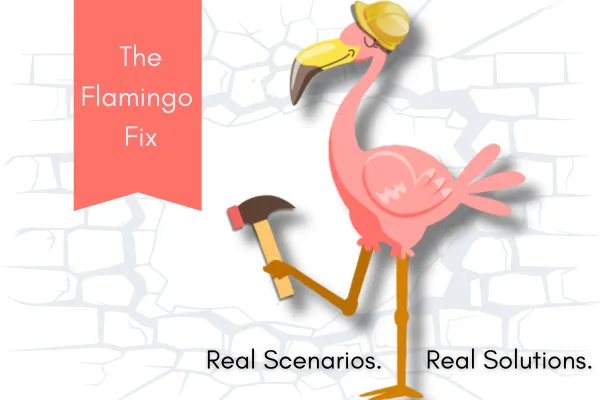Read the Blog!

Flamingo Fix 025: When good systems and boundaries get bypassed anyway
You don't need better systems and boundaries. You need to know why you keep breaking the ones you have.
Let us tell you a story...
Josh kept accepting clients he shouldn't. Nightmare projects. Difficult people. People who made his work miserable.
At first glance, you'd think: "Josh is people-pleasing! He needs better boundaries!"
Wrong on the first count. Right on the second.
Josh wasn't trying to make anyone happy. He feared going broke.
He bypassed his own systems because he was terrified of what would happen if he said no. What if no one else paid? What if he couldn't feed his family? What if this was his last chance to pay rent?
Those voices swirled in his head constantly.
Josh stopped bypassing his systems AFTER he dealt with his scarcity mindset and solved his lead gen problem.
When he had a steady flow of leads coming in, he had no problem walking away from money when people didn't meet his standards. That’s when he set three conditions people must meet before he'd work with them.
🦩Here's why this matters to you, your boundaries and your business systems...
If Josh had focused on creating "better" systems without addressing why he kept bypassing them, he would still be making exceptions every time fear kicked in.
Resist the temptation to tweak and retweak your systems for greater efficiency and “better boundaries”. Understand which of the three root causes drives your boundary and system violations.
Is it a Mindset Issue? You know you should stick to your systems, but the internal pig stinking thinking voices keep you stuck. Here comes the money scarcity, rejection fears, people-pleasing, etc.
Is it a Boundary Issue? You're doing the mindset work and are committed to having business boundaries that serve your people AND yourself. You may still be trying to figure out what feels fair for everyone and safe for you to uphold.
Is it a Systems Issue? You know your boundaries, but your business systems don't quite reflect them yet. You need processes that support your boundaries and equip you to maintain them.
Take the Boundary Root Cause Assessment first.
Identify and tackle what's actually causing you to override your best business judgment. Then your systems hold.
🦩The Full Pink System: The Boundary Root Cause Assessment
STEP ONE: Pick One System That Gets Bypassed Regularly
Choose the one system bypass that costs you the most time, money, or emotional energy. Examples:
Team missing deadlines without early communication
Scope creep (additional work requests)
Communication boundaries (wrong channel, after-hours contact)
Skipping approval processes for "urgent" requests
Answering emails during family time "just this once"
Saying yes to rush projects that mess up your schedule
Write down: What's the specific system that gets bypassed and how much it's costing you (time, money, stress).
STEP TWO: Identify Why YOU Bypass This System
Think about the last time you made an exception to this specific system. Notice the pattern in your thoughts.
Ask yourself: "What was going through my head when I decided to bypass my own system?" Is it because:
"I can't say no - what if they leave/get upset/think I'm difficult?" (Fear-based thinking)
"I don't know what's fair here or it didn’t feel safe to do it - maybe I should help this time?" (Boundary uncertainty)
"I should stick to my policy but I don't know how to handle this request or situation." (System gap)
Pick the thought at the forefront of your mind. Then move the step 3. After implementing step 3, come back to this step to check which thought moves to the forefront of your mind.
STEP THREE: Address Boundary Violations Early
MINDSET ISSUES → Deal with the Mindset First
Problem: Fear overrides good judgment.
Solution: Address fears associated with this scenario before building systems. No system will hold consistently until you address your fears. If you haven't started the mindset work, we cannot help you.
BOUNDARY ISSUES → Define Fair + Safe Standards
Problem: You’re unclear what's fair for everyone involved
Solution: Sit down and think through what boundary would feel fair for everyone involved AND safe for you to implement in this specific scenario.
Josh's Boundaries: He determined three things clients must have before they work together AND three other experts client must hire apart from working with him. This honored his delivery ability AND prospects' right to solutions that work.
SYSTEMS ISSUES → Create A Three-Level Boundary Violation Protocol
Problem: You know your boundary but need systems that prevent violations, catch them early, and handle them consistently.
Solution: Build prevention, detection, and response systems.
Prevention: Build this boundary into your entire workflow from start to finish in a way that considers what your client, team and you need to thrive.
Early Detection:
Warning signs: What signals indicate your prevention system is failing and someone is about to bypass this boundary?
Measurement: What milestones and key success actions can you track to catch potential violations before they happen?
Response Protocol: Create consistent violation responses and enforcement plans. When this boundary gets crossed, exactly how will you respond?
Josh's System:
Prevention: Built qualification into his client screening process. He also incorporated his requirements into his client onboarding process and educated prospects.
Detection: Tracked temptation patterns and success metrics
Violation Response: Created scripts and a plan for turning prospects away.
🦩Your 5-Minute Pink Process Rescue
Pick one system you keep bypassing.
For the next week: Before you break this system again, use the assessment to identify the root cause first. Handle that instead of just making another exception.
Track it: When you handle the root cause, do you feel good about your decision?
Root cause solved = system holds.
🦩Your Next Pink Steps
Fear driving your decisions? Start doing the mindset work first.
Ready to build systems that hold? Two paths:
Have a bootstrapped messy backend? Book a call → https://clientsuccessexperts.com/curiosity-call
Have streamlined systems but you and clients/team members keep breaking them? Pink Systems Intensive →https://link.phoenixvirtual.pro/widget/bookings/process-structure
Not ready? Keep reading our emails. You'll know when.
Real expertise isn't following a roadmap perfectly—it's knowing when and how to adapt the map.




